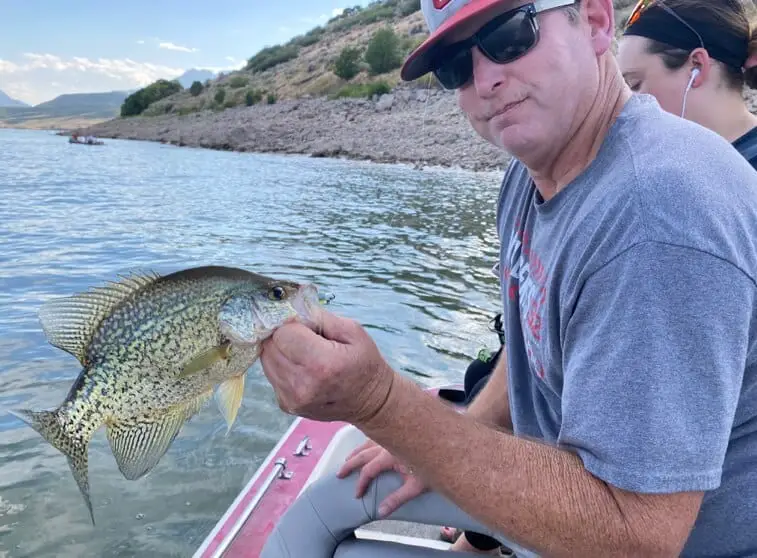Crappie, a type of panfish found in freshwater lakes across the U.S. and Canada, is a well-known and popular fish to catch. There are two varieties of crappie–white and black–and both are found in most of the 48 contiguous states. But are crappie good to eat?
The short answer is: Yes!
Crappie is absolutely good for eating. Both species are completely harmless to eat and a big part of the seafood diet of people all over North America. Particularly in the U.S. south. People have been eating and enjoying crappie for hundreds of years, developing cooking methods that bring out all the best flavors in this gorgeous fish.
In this article, we’ll cover all the ins and outs of crappie: what they taste like, how to prepare them, and we’ll also share some tips to make your next crappie meal not so crappy (get it?)
Are Crappie Good to Eat?
Crappie is one of the most widespread panfish in the continental U.S. and Canada. That means people have been refining fishing techniques and cooking traditions for this spectacular freshwater fish for years.
You’ll find crappie in different dishes all over the place. Fish fries in the south favor breaded crappie with a spicy blend, while northerners often cook and bake crappie as part of a stew.
As you might expect, there are hundreds of recipes available for crappie. But the fish is a great source of healthy macronutrients and vitamins itself. Crappie is high in fat and protein like other panfish. Their diet makes them more nutritious than similar fish species like bluegill.
They primarily eat insects and crustaceans in cold, clear freshwater lakes and rivers. Almost all freshwater fish share with them a diet rich in insects. Occasionally, they feed on the offspring of predator fish like walleye. So, are crappie good to eat? Absolutely. But what does crappie taste like?
What Does Crappie Taste Like?
Tastes differ from person to person, but there is a general consensus on the taste of crappie. Black and white crappie taste similar. The flavor profile is very mild, like tilapia. They have very little red meat in their flesh, which partially accounts for its mild (sometimes bland) flavor.
The fish with a flavor closest to crappie is probably bluegill. However, the texture of crappie differs from bluegill. On average, crappie is softer and flakier than bluegill and other freshwater panfish. This means they can be easier to overcook, as the flesh is more delicate.
The milky white flesh of crappie is what accounts for its soft, smooth mouthfeel. If you catch a crappie with excessive red meat, it’s best to trim it off. Red meat on crappie gives off a very strong fishy taste and smell that many people dislike.
Crappie taste varies from fish to fish, but there are ways to predict how a certain population of crappie will likely taste. The colder and cleaner the water, the more muscular and thicker the flesh will be. Crappie from warm water sources tends to be very soft, perhaps mushy in the worst cases. The brighter the fish scales, the fresher the fish will be with a less fishy taste.

How To Prepare Crappie
You’ll need to catch a lot of crappies to feed a large party or family. They’re not like bass or catfish. These fish have remarkably little edible flesh on them, so you’ll need to prepare more fillets than you might expect. Luckily, crappies live in large schools. With patience, you should be able to catch ten crappies if you catch one. Preparing crappie is another matter.
Below, we’ve laid out just a few of the traditional ways to prepare crappie. It is a versatile fish with an inoffensive taste, making it great for cooking whole, chunking, breading, baking, and more.
Filleting Crappie
If you’re familiar with filleting small fish like bluegill, the filleting process for crappie is nearly identical.
- Gut the fish by thrusting the knife between the pectorals, running a knife down the vent, and flushing out all the innards.
- Insert the fillet knife behind the head and gill plate, then cut down to the spine.
- Twist the knife 90 degrees, parallel to your cutting board, and cut toward the tail
- Stop short of the tail, flip the fillet over, remove the scales.
- Put the knife between the skin and meat and pull the knife toward you, sliding it to the other end of the fish. You’ve just filleted crappie.
Cooking Crappie
When your crappie fillets are ready, look them over carefully for bones. They are very tiny, so you’ll need tweezers or a pinching tool to remove them. Run the fillets over cold water before cooking them to ensure no guts or scales remain either.
The main thing about cooking crappie is not to overcook them. Three minutes per side is the maximum amount of time you’ll need to cook them through. One and half minutes is usually enough.
Adding hot sauces to pan-fried crappie is traditional and very tasty. Marinating crappie is another way to make sure they stay juicy after cooking.
Grilling Crappie
Grilling crappie is less popular than pan-frying and deep-frying. But can you eat crappie from the grill? Yes–it’s delicious!
The delicate flesh can easily break apart if you’re not careful. We recommend using a fish basket on the grill. It will help retain the shape of crappie fillets, and it’s useful for grilling lots of fish simultaneously.
Baking Crappie
Baking crappie is another option, popular in the northern U.S. Preheat your oven to 400 degrees and bake for about 20 minutes. For best results, put your fillets or chunked fish in an aluminum foil packet. Brush them with olive oil, lemon, and butter. Simple but delicious.
Crappie Fishing Resources
- Not Catching Crappie? Here are 8 Reason’s Why
- Crappie Fishing 101: How To Fish For Crappie Like A Pro
- How to Catch Crappie
- Best Ways to Cook Crappie
Conclusion
If you enjoy fish but not the fishy aftertaste, crappie is the ideal freshwater panfish for you. It’s easy to cook too: the only thing to avoid is overcooking.
We hope you’ve enjoyed our brief but detailed intro to crappie taste and cooking methods. As long as you remember to catch a lot of them, you should have a hit party or gathering the next time crappie is on the menu!

